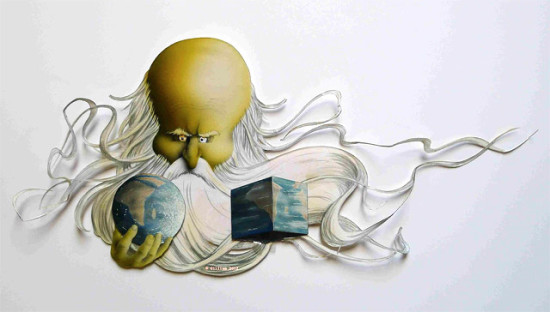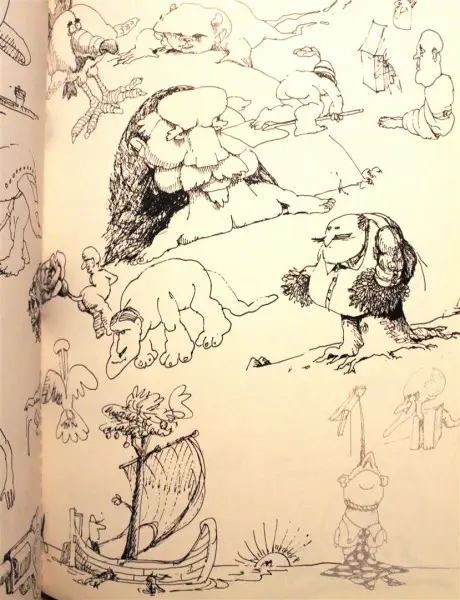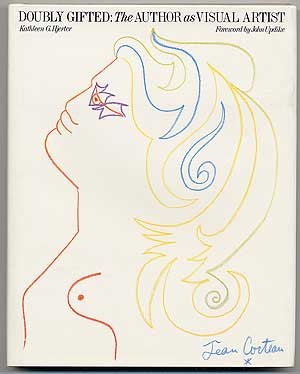by Jas Faulkner

Why do people draw in books?
A friend of mine borrowed my copy of the script for Monty Python and the Holy Grail for a scene study class. She returned it with thanks but a grumpy rejoinder about the copious scribbling along the margins. After listening to more grumbling, I finally broke it to her that the bizarre creatures were actually printed in the book. They were the handiwork of the film’s animator and co-director, Terry Gilliam.
She had every reason to believe that the artwork was mine. However, she had no idea that Gilliam, and for that matter the rest of the artists often still known as Monty Python, had been influences for decades. My father passed his adoration of the Pythons to me when I was stranded in a Tea Party Before There Was A Tea Party prep school in the midwest because his job demanded we live in The Breadbasket of America for a year. It was then that I discovered comedy was a way to stay sane. Gilliam’s adorably demented creatures gamboled across every Monty Python book I owned. Of course I copied him.
Many years later, I would find copying Terry Gilliam probably kept me from completely losing my composure and emulating Little Regan from The Exorcist in a 200-level literature series.

It was a writing intensive kind of course, but more along the lines of creative writing with a sadistic twist. Sometimes the words wouldn’t come and I couldn’t be arsed to care. After all, I’d been told no one would want to read them anyway. To steal a riff from an internet meme, it’s that moment when you’re writing with the knowledge (and the freedom) that no one is reading.
My English Lit teacher was one of those people who loved to appear all crunchy and hug-the-planet. In truth he was the kind of individual who got the jellies over making people cry during critiques. He must have been under the impression that every author with an entry in the weighty laminated hardbound textbook we dutifully lugged to class three times a week suffered for their art and that we, being callow writer larvae, could not fully appreciate what we were reading until we had suffered along with our comrades-in-ink. So every time we read something, we had to write our own story/poem/play/laundry list/suicide note in the same style.
This might have been a fun project if it hadn’t been taught by a man who most likely spent his evening hours as his true self, an incubus who sucked the life out of small mammals and graduate students in the marsh that bordered the western edge of the campus. Every assignment sapped us of our love of words. I took to drawing in my book, resale to the campus store be damned. The result was something akin to evidence of a glorious misspent youth in the Mississippi heat with Staedler pens going exactly where they were not meant to go:
T.S. Eliot proclaimed his less than sylvan love for Idi Amin to David Letterman
Matthew Arnold was revealed as having a yen for eating Top Ramen in Spiderman Underoos while he waited for inspiration to finish his masterpiece.
Shakespeare was really Pocahontas and a Turkish eunuch, both of whom had been brought to England as curiosities and who ran away to Stratford-on Avon to escape the White Gaze and write in peace.
Some people burn though textbooks with copious notes and scattered highlighted lines and ball-point underlining. The text is there among the intellectual process showing how the book’s owner came to internalize what was written.
As I worked my way though the textbook, the words of the masters were obscured. My detailed rendering got more aggressive and vivid as the instructor’s contempt for my writing got more obvious over the course of the semester. I dutifully turned in every paper, and every page of the text ceased to bear the the victims of his academic scrutiny.
As he read my assignments as examples of what not to do, I drew detailed dragons that were almost as delicate as figures from a tapestry. They ate him and Virginia Woolf as part of a plate full of nori rolls.
He was also sat upon by a sumo wrestler with the head of a chihuahua at one point after he sniffed that my writing was hopelessly proletariat.
It was bratty and it was rude, but it was my way of shouting back that I would be a writer without endangering my grade.
 Almost a decade later, I found the text in a box of high school yearbooks I was throwing away. Both amused and appalled by the pictures, I left the book out on my coffee table for people to giggle at. Someone must have liked it so much that it left my house, tucked under their arm. I guess they felt it needed to live with them for a while.
Almost a decade later, I found the text in a box of high school yearbooks I was throwing away. Both amused and appalled by the pictures, I left the book out on my coffee table for people to giggle at. Someone must have liked it so much that it left my house, tucked under their arm. I guess they felt it needed to live with them for a while.
Do all writers doodle? I think a fair amount of them do. Even though computers have replaced pens and paper for many of us, there is almost always something to write with and on somewhere. And my Lit text might be long gone, but there are a few collections around of writers who wander into the chambers of other muses. One of my favorites is Kathleen Hiertner’s Doubly Gifted: The Author as Visual Artist (1986 Harry N. Abrams, New York). In it you will find a generous helping of desk top doodles and notebook visual tangents that will give you insight into the authors’ creative process.
So the next time you feel the urge to draw, I say go for it. It’s a great release. Who knows? You may find some talent you had no idea you possessed!
